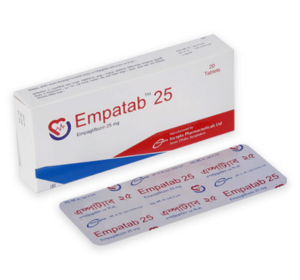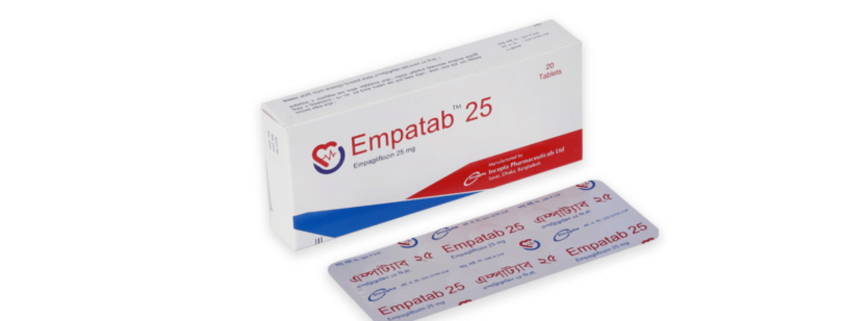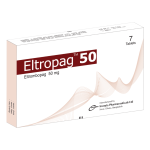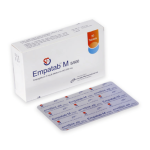Empatab(Empagliflozin)
Therapeutic Group: Sodium-glucose Co-transporter 2 inhibitor

Presentation
Empatab 10: Each film coated tablet contains Empagliflozin INN 10 mg.
Empatab 25: Each film coated tablet contains Empagliflozin INN 25 mg.
Description
Empagliflozin is an inhibitor of Sodium-glucose co-transporter 2 (SGLT2). By inhibiting SGLT2, Empagliflozin reduces renal reabsorption of filtered glucose and lowers the renal threshold for glucose and thereby increases urinary glucose excretion.
Indications
Empagliflozin is indicated as an adjunct to diet and exercise to improve glycemic control in adults with type 2 diabetes mellitus.
Dosage & Administration
The recommended dose of Empagliflozin is 10 mg once daily in the morning, taken with or without food. In patients tolerating Empagliflozin 10 mg, the dose may be increased to 25 mg. for additional glycemic control.
Assessment of renal function is recommended prior to initiation of Empagliflozin and periodically thereafter. Empagliflozin should not be initiated in patients with an eGFR less than 45 mL/min/1.73 m2. Empagliflozin is limited to 10 mg once daily in patients with an eGFR greater than or equal to 45 mL/min/1.73 m2. Empagliflozin should be discontinued if eGFR is persistently less than 45 mL/min/1.73 m2
Side Effects
Hypotension, impairment in renal function, hypoglycemia with concomitant use with insulin and insulin secretagogues, genital mycotic infections, urinary tract infections, increased low-density lipoprotein cholesterol (LDL-C).
Precautions
Hypotension: Before initiating Empagliflozin, volume status should be assessed and correction on hypovolemia should be made in the elderly, in patients with renal impairment, in patients with low systolic blood pressure and in patients on diuretics since Empagliflozin causes intravascular volume contraction.
Impairment in Renal Function: Renal function should be evaluated prior to initiating Empagliflozin and periodically thereafter since Empagliflozin increases serum creatinine and decreases eGFR.
Hypoglycemia: In patients taking insulin or an insulin secretagogue with Empagliflozin, a lower dose of insulin or the insulin secretagogue is considered to reduce the risk of hypoglycemia.
Genital mycotic infections: Monitoring and treatment should be done if indicated.
Urinary Tract Infections: Monitoring and treatment should be done as appropriate.
Increased LDL-C: Monitoring and treatment should be initiated if required.
Use in Pregnancy & Lactation
Pregnancy: Pregnancy Category C. There are no adequate and well-controlled studies in pregnant women. Use during pregnancy only if the potential benefit justifies the potential risk to the fetus. Nursing Mothers: Discontinue Empagliflozin or discontinue nursing.
Drug Interaction
Diuretics: Coadministration of Empagliflozin with diuretics enhances the potential for volume depletion. Insulin or Insulin Secretagogues: Coadministration of empagliflozin with insulin or insulin secretagogues increases the risk for hypoglycemia.
Over Dose
There were no reports of overdose during the clinical development program for Empagliflozin. Removal of Empagliflozin by hemodialysis has not been studied.
Storage
Do not store above 300 C. Keep out of the reach of children.
Commercial Pack
Empatab 10: Each box contains 3 blister strip of 10 tablets.
Empatab 25: Each box contains 2 blister strip of 10 tablets.



